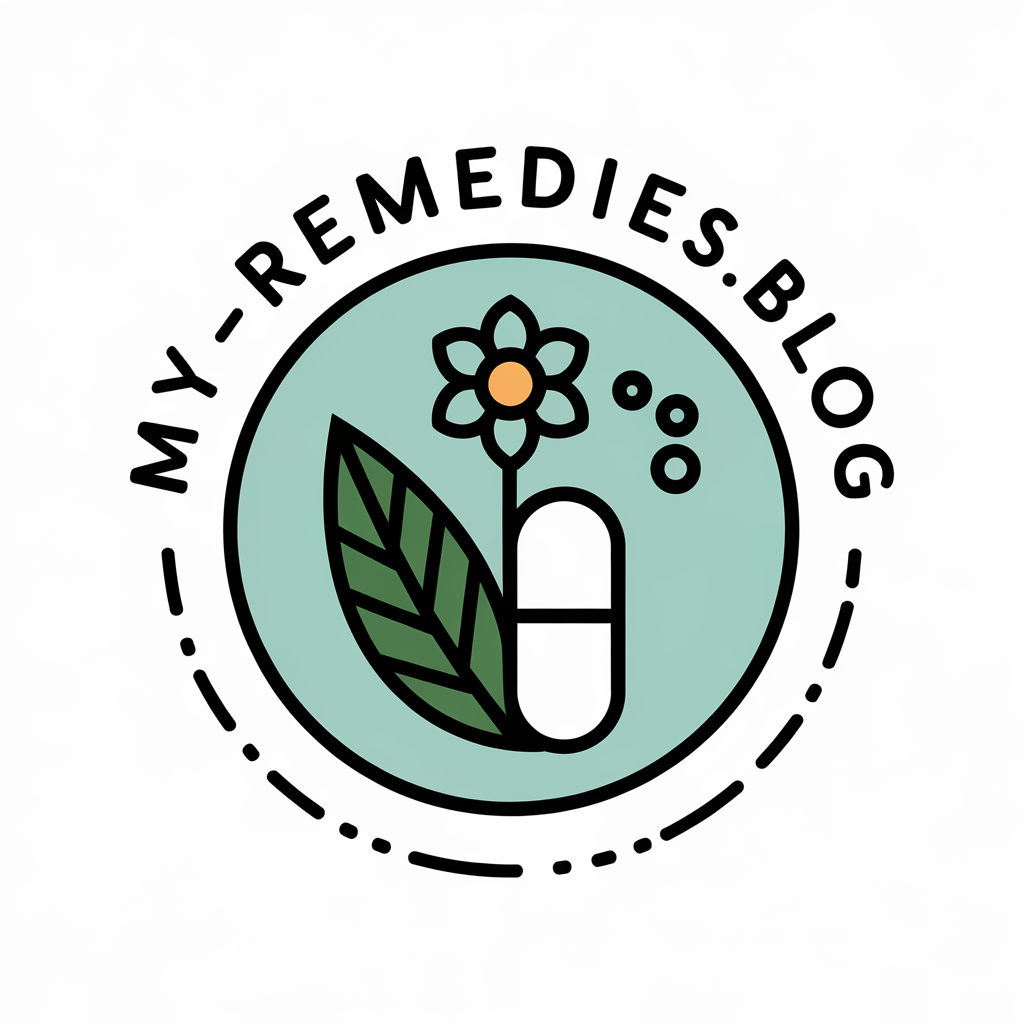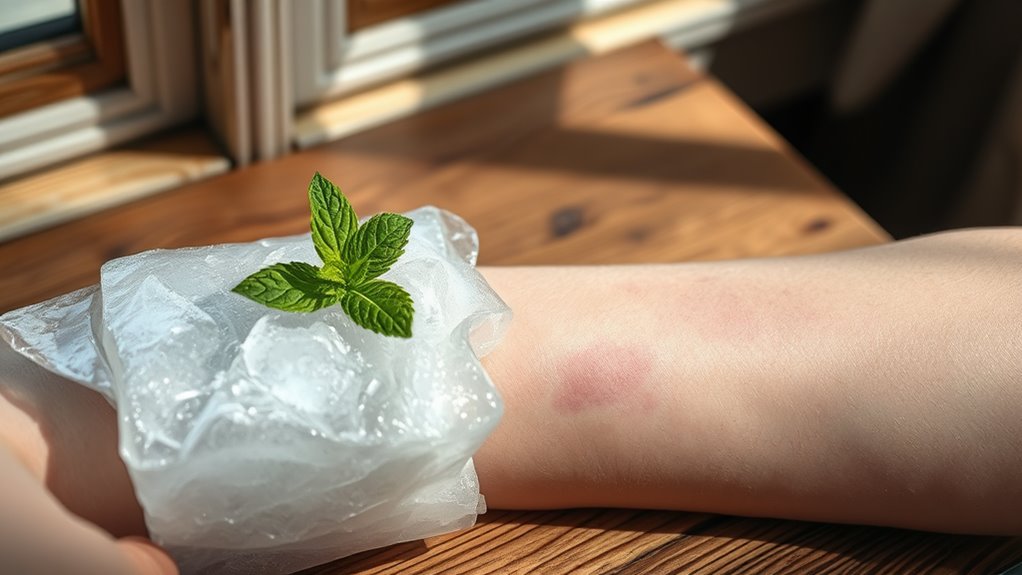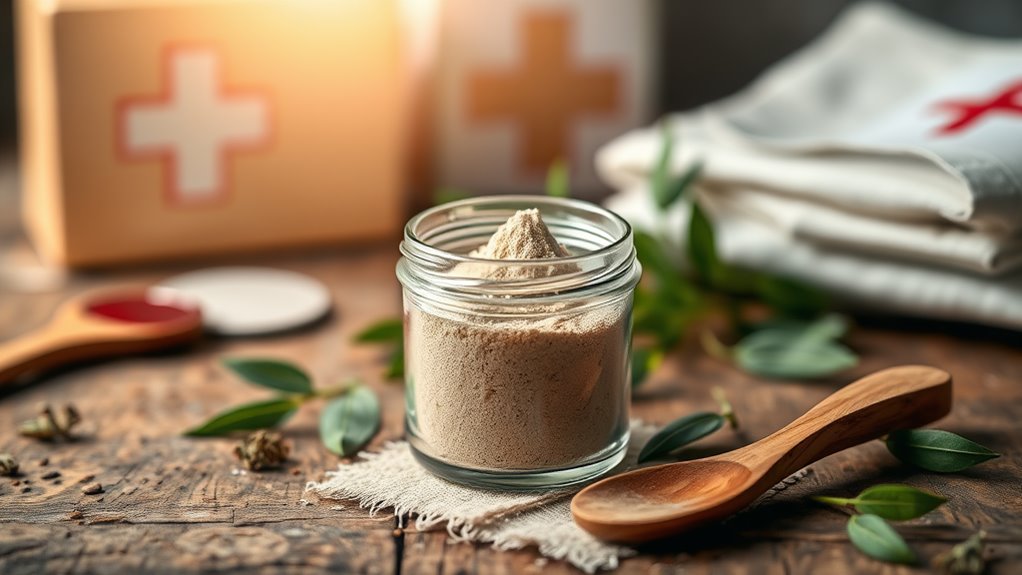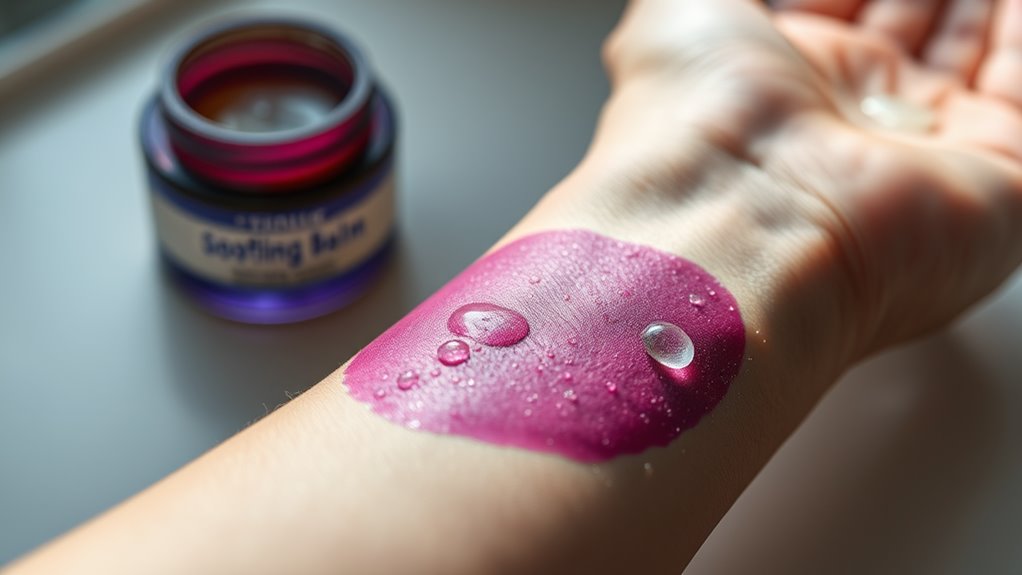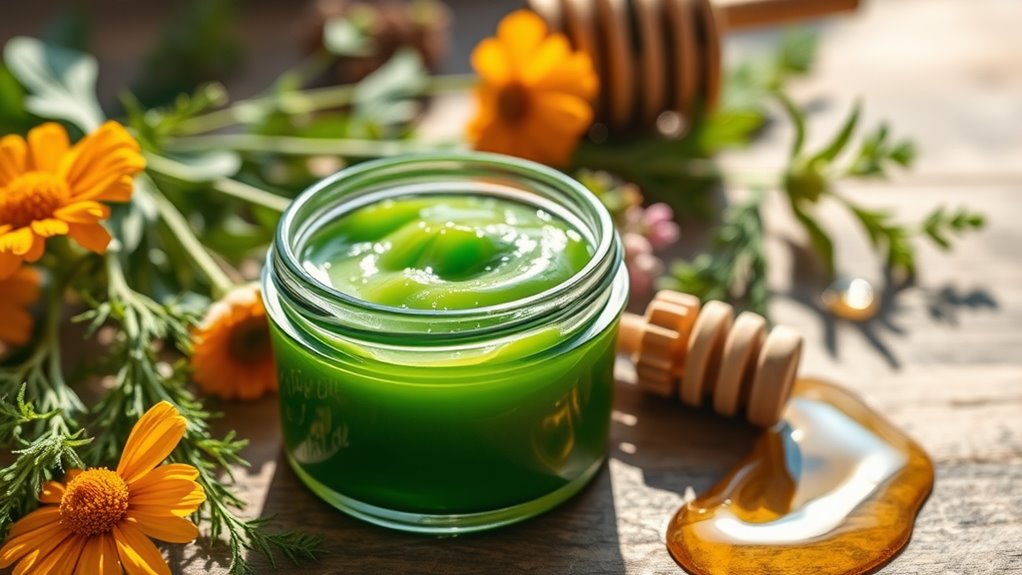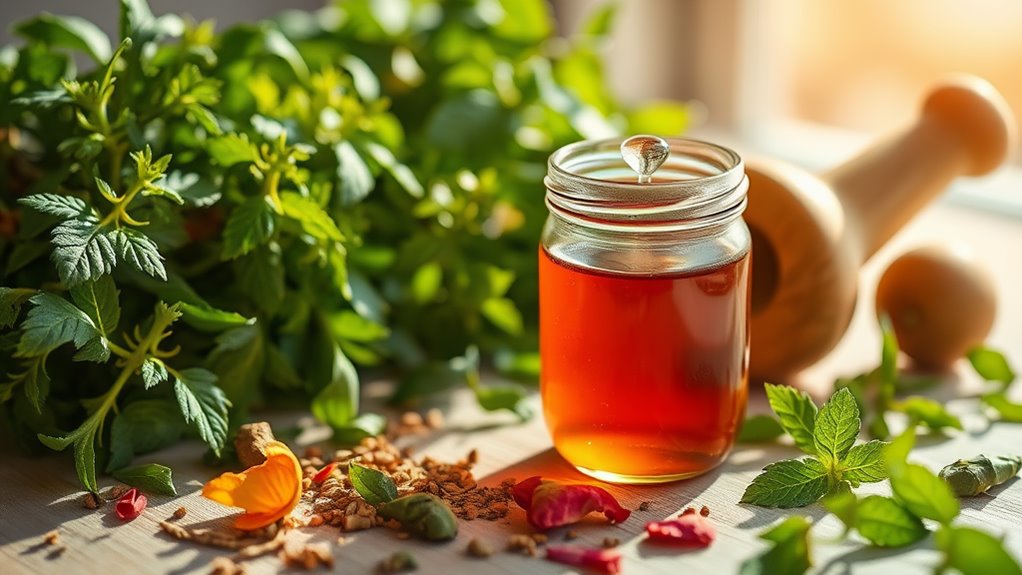Heal Bruises Fast With This Ice Pack Infusion Trick
To heal bruises fast, try an ice pack infusion using natural ingredients like arnica or chamomile. Simply boil your chosen herbs in water, cool the infusion, strain it, and add ice cubes to a sealable bag with the liquid. Apply this ice pack to your bruise for 15-20 minutes, ideally within the first 48 hours. This combination promotes healing while reducing swelling. For more tips and techniques to boost your recovery, keep exploring!
Key Takeaways
- Create an ice pack infusion using herbs like arnica or chamomile to enhance healing and reduce swelling.
- Apply the ice pack for 15-20 minutes every hour during the first 48 hours post-injury.
- Elevate the bruised area above heart level to minimize swelling while using the ice pack.
- Stay hydrated by drinking water and consuming hydrating foods to support tissue repair.
- Monitor the bruise for changes and seek medical attention if severe pain or signs of infection occur.
Understanding Bruises and Their Healing Process
When you bump into something, the impact can cause blood vessels under your skin to break, leading to a bruise. This dark discoloration occurs as blood leaks into the surrounding tissue.
You might notice that bruises change color over time, evolving from red to purple, and eventually yellow or green as they heal. The healing process typically takes a few days to weeks, depending on the severity. Using herbal remedies that promote collagen synthesis can significantly enhance this healing process.
To speed things up, consider using a natural bruise remedy. Some effective options include arnica gel, which can reduce swelling, or applying aloe vera to soothe the skin. Additionally, applying ice wrapped in a cloth can help reduce swelling in the first 24 hours after the injury.
Staying hydrated and maintaining a healthy diet rich in vitamins C and K can also support your body’s healing process, helping those bruises fade faster.
The Benefits of Cold Therapy for Bruises
Cold therapy can be incredibly effective for managing bruises, as it helps minimize swelling and numbs the pain associated with the injury.
By applying cold to the affected area, you constrict blood vessels, which reduces blood flow and limits the extent of the bruise. This not only helps with swelling but also speeds up the healing process.
Additionally, the numbing effect can provide immediate relief, making it easier for you to move and function without discomfort.
To get the most benefit, use cold therapy within the first 48 hours after the injury occurs.
Remember to wrap ice packs in a cloth to protect your skin.
Incorporating cold therapy into your recovery routine can make a noticeable difference in how quickly your bruise heals.
Choosing the Right Ingredients for Your Ice Pack Infusion
What ingredients should you consider for your ice pack infusion to maximize its effectiveness? First, think about using herbal remedies like arnica or chamomile, known for their anti-inflammatory properties. Both can help reduce swelling and promote healing in bruised areas. Additionally, incorporating turmeric’s curcumin into your routine can further support healing due to its anti-inflammatory and antioxidant effects.
Essential oils, such as lavender or peppermint, can add a soothing element while enhancing circulation. You might also consider adding a few drops of vitamin E oil, which can support skin regeneration.
For a revitalizing touch, infusing your ice pack with green tea could provide antioxidants. Finally, don’t forget a pinch of sea salt—this can help with the freezing process, ensuring your pack stays cold longer. Incorporating gentle stretching techniques alongside your ice pack can also aid in alleviating discomfort and improving overall recovery.
Choose ingredients based on your personal preferences and sensitivity for the best results!
Step-by-Step Guide to Creating Your Ice Pack Infusion
To create an effective ice pack infusion, you’ll want to follow a straightforward process that maximizes the healing benefits of your chosen ingredients. Start by gathering your materials, then prepare your infusion.
| Step | Action |
|---|---|
| 1. Prepare | Combine your chosen herbs and water in a pot. |
| 2. Boil | Bring the mixture to a boil, then simmer for 10 minutes. |
| 3. Cool & Strain | Allow it to cool, strain out the solids, and pour the liquid into a sealable bag. |
Next, add ice cubes to the bag, seal it tightly, and your ice pack infusion is ready! This easy method guarantees you harness the full power of your ingredients for faster bruise recovery.
Applying the Ice Pack Infusion Effectively
To apply your ice pack infusion effectively, start by choosing the right ice and duration for ideal results.
You’ll also want to incorporate elevation and compression techniques to enhance healing.
Let’s explore how these elements work together to speed up recovery.
Choose the Right Ice
When you’re dealing with bruises, choosing the right ice can make a significant difference in your recovery time.
You want to opt for ice packs that mold well to your skin, ensuring even coverage. Gel packs are often ideal since they conform to your body and stay cold longer.
If you’re using ice cubes, wrap them in a thin towel or cloth to avoid direct contact, which can harm your skin. Frozen peas are another great option; they’re flexible and can easily adapt to the area of your bruise.
Duration of Application
While applying ice is essential for treating bruises, knowing how long to keep it on can make all the difference in your recovery. Aim for 15 to 20 minutes per session, ensuring you give your skin a break afterward. This prevents frostbite and allows your skin to warm up again.
You can repeat the application every hour, especially during the first 48 hours after the injury. Keep an eye on how your bruise feels and looks; if it seems to worsen, ease up on the frequency.
Always use a cloth or towel between the ice pack and your skin to protect your tissue. Following these guidelines will help speed up your healing process and minimize discomfort.
Elevation and Compression Techniques
Elevating the injured area and applying compression can greatly enhance the effectiveness of ice treatment for bruises. By doing so, you help reduce swelling and improve blood circulation, speeding up healing. Here’s how to apply these techniques effectively:
| Step | Action | Benefit |
|---|---|---|
| Elevate | Raise the injured area above heart | Reduces swelling |
| Compress | Wrap with a bandage or cloth | Minimizes blood flow to injury |
| Apply Ice Pack | Use the infusion pack on bruise | Reduces pain and inflammation |
| Repeat | Perform every few hours | Encourages faster recovery |
Incorporating these techniques with your ice treatment will help you heal bruises faster and feel better sooner.
Additional Tips for Speeding Up Bruise Recovery
To speed up your bruise recovery, you can take a few simple steps.
Elevating the affected area and applying arnica gel can greatly reduce swelling and pain.
Plus, don’t forget to stay hydrated, as it plays an essential role in your body’s healing process.
Elevate Affected Area
When you raise the affected area above heart level, you can markedly speed up bruise recovery.
Elevation helps reduce swelling and promotes better blood circulation, which aids healing.
Here are some tips to keep in mind:
-
Find a comfy position: Use pillows or cushions to elevate the bruise comfortably.
-
Stay still: Limit movement to avoid aggravating the injury.
-
Combine with ice: Use an ice pack while elevated to further reduce swelling.
-
Keep it elevated: Try to maintain this position for 15-20 minutes several times a day for ideal results.
Apply Arnica Gel
Arnica gel is a powerful ally in speeding up bruise recovery. This natural remedy, derived from the arnica plant, helps reduce inflammation and promotes healing.
To use it effectively, apply a thin layer of gel directly to the bruise three to four times a day. Make sure to gently massage it into the skin, allowing your body to absorb its beneficial properties.
You’ll want to avoid applying it on open wounds or broken skin, as it can cause irritation. Consistency is key; the sooner you start using arnica after getting a bruise, the better your results will be.
With regular application, you’ll notice your bruise fading faster, helping you get back to your normal activities in no time.
Maintain Hydration Levels
Staying hydrated is essential for speeding up bruise recovery. Proper hydration helps your body repair damaged tissues and reduces inflammation.
Here’s how you can maintain your hydration levels effectively:
-
Drink Water: Aim for at least 8 glasses a day. Water is your best friend in recovery.
-
Eat Hydrating Foods****: Incorporate fruits and vegetables like cucumbers, oranges, and watermelon into your diet. They’re high in water content.
-
Limit Caffeine and Alcohol: Both can dehydrate you, slowing down recovery.
-
Use Electrolytes: Consider adding electrolyte drinks when you’re active or sweating, as they help retain fluid balance.
Safety Precautions When Using Ice Packs
Although ice packs can be incredibly effective for reducing bruising and swelling, it’s essential to use them safely to avoid skin damage.
Always wrap the ice pack in a thin cloth or towel before applying it to your skin; direct contact can cause frostbite. Limit your ice pack sessions to 15-20 minutes at a time, allowing your skin to return to normal temperature between applications.
If you experience any discomfort, numbness, or skin irritation, remove the ice pack immediately. Be cautious when using ice packs on sensitive areas, like the face or joints.
Finally, consult with a healthcare professional if you’re unsure about using ice packs or if your condition worsens. Stay safe while speeding up your recovery!
When to Seek Medical Attention for Bruises
Wondering when it’s time to seek medical attention for a bruise?
While most bruises are minor, some situations require professional evaluation.
Keep an eye out for these signs:
-
Severe Pain: If the pain doesn’t improve or worsens over time, it might indicate a fracture.
-
Large Bruises: Bruises larger than a quarter or those that appear without clear cause can raise concerns.
-
Frequent Bruising: If you notice unexplained bruises appearing often, it may signal a more serious underlying condition.
-
Signs of Infection: If the bruise becomes red, warm, or swollen, or if you develop a fever, seek immediate care.
When in doubt, it’s always better to consult a healthcare professional!
